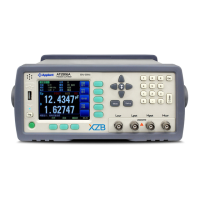67Command Reference
Example:
function:imp:type Cp-D
function Subsystem Command
imp Level 2
type Level 3
Cp-D Parameter
The basic rules of the command tree are as follows.
Letter case (upper and lower) is ignored.
For example,
FUNCTION: IMPEDANCE = function:impedance
Spaces (_ used to indicate a space) must not be placed before and/or after the
colon (:).
For example,
func_:_imp func:imp
The command can be completely spelled out or in abbreviated.(The rules for
command abbreviation are described later in this section)
For example,
function: impedance = func:imp
The command header should be followed by a question mark (?) to generate a
query for that command.
For example,
function:imp?
The semicolon (;) can be used as a separator to execute multiple commands
on a single line. The multiple command rules are as follows.
Commands at the same level and in the same subsystem command group can
be separated by a semicolon (;) on a multiple command line.
For example,
func:imp:type cp-d ; rang 4
To restart commands from the highest level, a semicolon (;) must be used as
the separator, and then a leading colon (:), which shows that the restarted
command is a command at the top of the command tree, must follow.
For example,
func:imp:range:auto on; : func:imp cp-d
The common commands can restart only after a semicolon on a multiple
function
:imp? :mon1 :imp
:type {…} rang?

